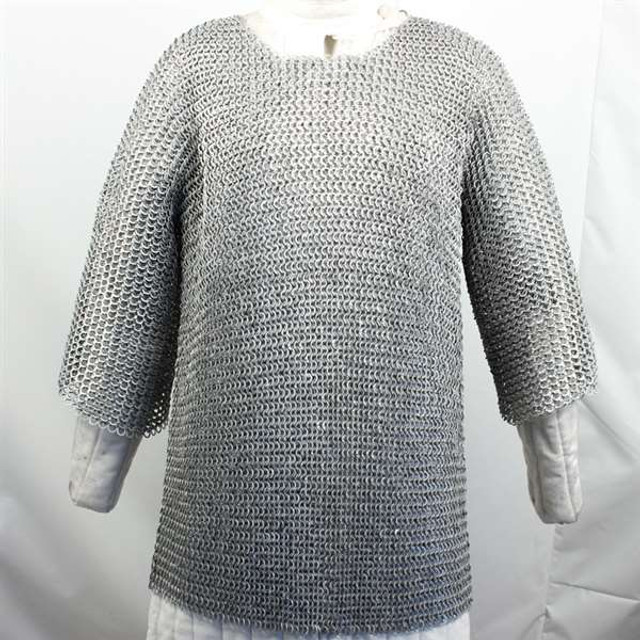Types of Medieval Armor: A Comprehensive Overview
Posted by SwordsSwords on Jun 25th 2024
Medieval armor is a fascinating subject, rich with history and innovation. From the flexible chainmail to the formidable full plate armor, each type of armor served a unique purpose and offered specific advantages on the battlefield. In this guide, we will delve into the different types of medieval armor, their uses, and their evolution over time.
Chainmail
Description and Use
Chainmail is one of the earliest forms of body armor. It consists of small metal rings linked together in a pattern to form a mesh. This armor was highly effective at protecting against slashing weapons and provided decent flexibility, allowing for greater mobility in combat.
Advantages
- Flexibility: The interconnected rings allow for a wide range of motion.
- Durability: Chainmail can absorb and distribute the force of a blow, reducing the impact.
- Repairability: Damaged sections can be easily replaced or repaired.
Specific Uses
Chainmail was often worn over a padded garment known as a gambeson, providing additional comfort and protection. It was used extensively by knights and foot soldiers alike throughout the medieval period.
Brigandine
Description and Use
Brigandine is a type of armor that combines both rigid and flexible elements. It consists of small metal plates riveted between layers of fabric or leather. This design provides excellent protection while maintaining a degree of flexibility.
Advantages
- Protection: The metal plates offer significant defense against both cutting and piercing attacks.
- Flexibility: The fabric or leather backing allows for some movement.
- Disguise: Brigandine can be worn under clothing, making it less conspicuous.
Specific Uses
Brigandine was popular among soldiers and mercenaries who needed effective protection without the weight and rigidity of full plate armor. It was often used in conjunction with other armor types for comprehensive protection.
Gambeson
Description and Use
A gambeson is a padded defensive jacket, often worn as a standalone piece or underneath other types of armor. Made from layers of quilted fabric, it provides protection against blunt force trauma and adds cushioning for more rigid armor.
Advantages
- Comfort: The padding absorbs shock and reduces the risk of injury from impacts.
- Versatility: It can be worn alone or in combination with other armor types.
- Affordability: Gambesons were cheaper to produce than metal armor, making them accessible to a wider range of soldiers.
Specific Uses
Gambesons were used by virtually all medieval warriors, from common soldiers to knights. When worn under chainmail or plate armor, they significantly enhanced the overall protective capability.
Full Plate Armor
Description and Use
Full plate armor represents the pinnacle of medieval armor technology. Made from interlocking plates of steel, it provides comprehensive protection for the wearer, covering almost the entire body.
Advantages
- Maximum Protection: Full plate armor offers unmatched defense against cutting, piercing, and blunt force attacks.
- Intimidation: The sight of a fully armored knight could be enough to demoralize opponents.
- Status Symbol: Owning a full body armor suit was a sign of wealth and status.
Specific Uses
Worn primarily by knights and high-ranking soldiers, knight's body armor was used in both combat and tournaments. The design of full plate armor evolved over time to become more articulated and tailored to the individual, enhancing both protection and mobility.
Functional Medieval Armor Today
Modern Uses
Today, functional medieval armor is often used in historical reenactments, film productions, and by enthusiasts of historical martial arts. Modern armorers use traditional techniques to create accurate reproductions, ensuring that these pieces are both authentic and functional.

Preservation of History
Understanding the history of body armor provides valuable insights into the technological advancements and cultural significance of these protective garments. Collectors and historians continue to study and preserve these artifacts, keeping the legacy of medieval warfare alive.
Where to Buy
When you're ready to purchase your own piece of medieval history, it's important to choose a reputable source. For a wide selection of high-quality medieval armor, check out swordsswords.com. They offer a variety of options to suit any need, ensuring you find the perfect armor for your collection or reenactment.
Conclusion
Medieval armor comes in many forms, each with its own unique benefits and applications. From the versatile chainmail to the imposing full plate armor, these protective garments were essential for survival on the battlefield. By studying the different types of medieval armor, we gain a deeper appreciation for the ingenuity and craftsmanship of the past.
Whether you're a history buff, a reenactor, or simply curious about the past, the world of medieval armor offers endless opportunities for exploration and discovery. For those interested in acquiring their own pieces, numerous suppliers offer functional medieval armor that captures the essence of this fascinating period.

